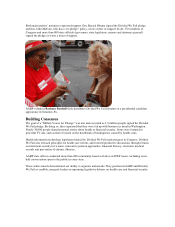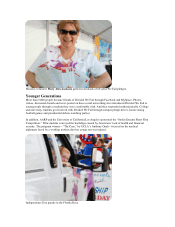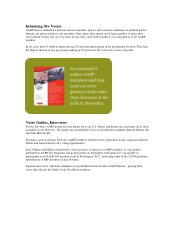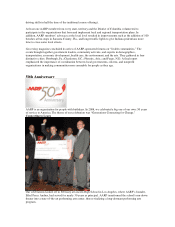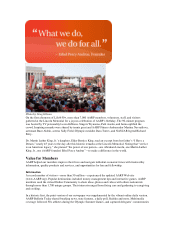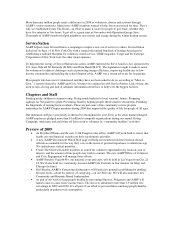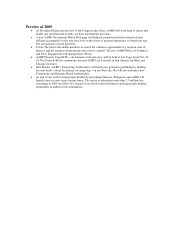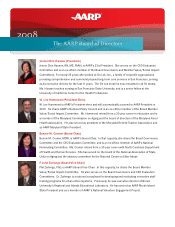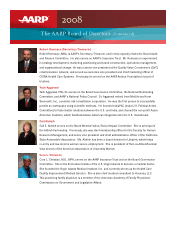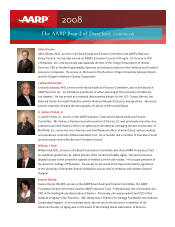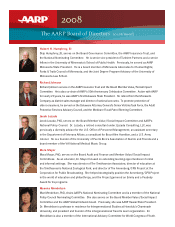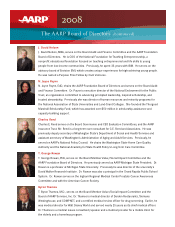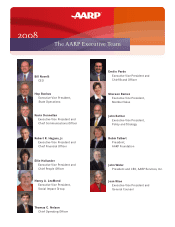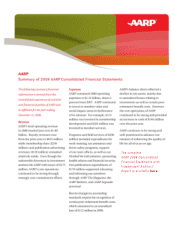AARP 2008 Annual Report Download - page 22
Download and view the complete annual report
Please find page 22 of the 2008 AARP annual report below. You can navigate through the pages in the report by either clicking on the pages listed below, or by using the keyword search tool below to find specific information within the annual report.More than nine million people made a difference in 2008 as volunteers, donors and activists through
AARP’s various networks. Many more AARP members wanted to help, but were pressed for time. That’s
why we established Create The Good—an effort to make it easier for people to give back, whether they
have five minutes or five hours. It got off to a great start in November with Operation Energy Save.
Thousands of AARP members helped neighbors save money and energy during the winter heating season.
ServiceNation
AARP helped create ServiceNation, a campaign to inspire a new era of service to others. ServiceNation
kicked off on Sept. 11 in New York City with a summit that united hundreds of leading Americans in
establishing a national blueprint for voluntary citizen service. TIME magazine, Target and the Carnegie
Corporation of New York were the other major sponsors.
To help turn the energy of ServiceNation into action, AARP endorsed the Serve America Act, sponsored by
U.S. Sens. Edward M. Kennedy (D-MA) and Orrin Hatch (R-UT). The legislation sought to make it easier
for volunteers to address challenges such as promoting energy efficiency, improving health care in low-
income communities and tackling the school dropout crisis. AARP was a strong advocate for its passage.
Most people who have never volunteered said they have not been asked to do so, according to “More to
Give,” a report released by AARP and Civic Ventures in conjunction with ServiceNation. Lack of time, the
need to earn a living and lack of adequate information about how to help were the biggest barriers.
Chapters and Staff
Sending needy children to summer camp. Fixing snack baskets for local veterans’ homes. Preparing
saplings for 3rd graders to plant. Preventing fraud by helping people shred sensitive documents. Polishing
the fingernails of nursing home residents. These are just some of the community service projects
undertaken by AARP Chapter members during 2008 that improved the quality of life for people of all ages.
Our dedicated staff gave generously of themselves throughout the year. Even as the stock market plunged,
AARP employees pledged more than $1 million to nonprofit organizations during our annual Giving
Campaign. And many took paid time off from work to volunteer in “community builders” activities.
Preview of 2009
• As President Obama and the new 111th Congress take office, AARP will work hard to ensure that
health care and financial security are their top domestic priorities.
• A new AARP Government Watch Web page will help our members hold their federal elected
officials accountable for the way they vote on the issues of greatest importance to Americans age
50+ and advance critical priorities.
• Create The Good will enable members to search for volunteer opportunities by location, area of
interest, and the amount of time people may wish to commit. The new AARP Office of Volunteer
and Civic Engagement will manage these efforts.
• AARP Presents Vegas@50+, our national event and expo, will be held in Las Vegas from Oct. 22-
24. We’ll also hold two community-focused AARP Life Festivals in San Antonio (in May) and
Chicago (in June).
• Gail Sheehy, AARP’s Caregiving Ambassador, will break new ground in publishing by drafting
her next book—about the journey of caregiving—on our Web site. We will also announce new
Community and Hispanic Brand Ambassadors.
• As part of our work to keep people healthy by preventing illnesses, Walgreens and AARP will
launch coast-to-coast tours via nine buses. The aim is to administer more than 2.5 million free
screenings in 2009 and 2010. It’s all part of our effort to prevent illness and keep people healthy,
particularly in underserved communities.


